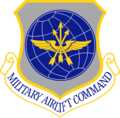1st Expeditionary Rescue Group  | |
|---|---|
 US Air Force pararescue personnel perform a hoist extraction of a survivor during an urban operations training exercise | |
| Active | 1943–1946, 1946–1956, 1995–1997, 2015– |
| Country | |
| Branch | |
| Role | Combat search and rescue |
| Part of | United States Air Forces Central Command |
| Mottos | "... These Things We Do, That Others May Live"[ citation needed ] |
| Equipment | HH-60 Pave Hawk Lockheed Martin C-130J Super Hercules |
| Decorations | Presidential Unit Citation |
| Commanders | |
| Current commander | Gregory A. Roberts |
| Notable commander | Virgil LO. Zoller |
| Insignia | |
| 1st Expeditionary Rescue Group emblem |  |
| 1st Air Rescue Sq emblem [note 1] [1] |  |
| 1st Emergency Rescue Sq emblem |  |
The 1st Expeditionary Rescue Group is a provisional unit of the United States Air Force assigned to Air Combat Command to activate or inactivate as necessary. It was activated in Southwest Asia in September 2015 to provide combat search and rescue for Operation Inherent Resolve.
Contents
- Units
- History
- World War II
- Caribbean operations
- Patrick Air Force Base
- Expeditionary operations
- Lineage
- Assignments
- Components
- Stations
- Aircraft
- Awards and campaigns
- See also
- References
- Notes
- Bibliography
- External links
The group was first activated during World War II as the 1st Emergency Rescue Squadron. After training with the United States Navy in Florida, the squadron moved to the Mediterranean Theater of Operations, where it flew Consolidated OA-10 Catalinas (and later other aircraft) to perform combat search and rescue missions, earning a Distinguished Unit Citation in August 1944. After VE Day, the squadron returned to the United States and was inactivated in 1946.
The group was activated later in 1946 as the 1st Rescue Squadron and was responsible for air rescue operations in the Caribbean and mid-Atlantic area. In 1952, it expanded to become the 1st Air Rescue Group, but was inactivated in 1956 as Air Force operations in the Caribbean were reduced. It was active again in 1995 at Patrick Air Force Base, Florida, where it provided rescue and range support for the Eastern Test Range. It was inactivated in 1997, when its component squadrons moved to Moody Air Force Base, Georgia and were reassigned, while the Eastern Test Range support mission was assumed by Air Force Reserve Command.
The group's mission is combat search and rescue.




